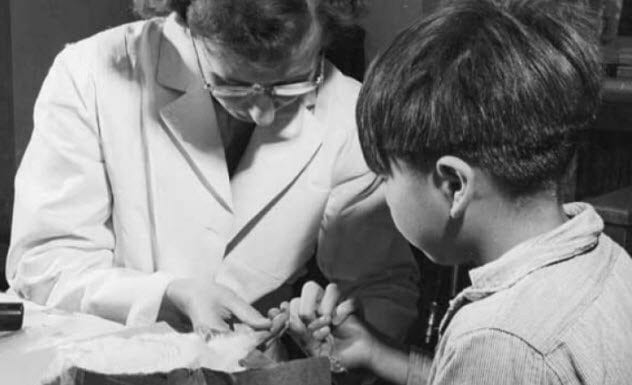 Politics
Politics  Politics
Politics  Weird Stuff
Weird Stuff 10 Eggs-traordinarily Odd Eggs
 History
History 10 Desperate Last Stands That Ended in Victory
 Animals
Animals Ten Times It Rained Animals (Yes, Animals)
 Mysteries
Mysteries 10 Devastating Missing Child Cases That Remain Unsolved
 Creepy
Creepy 10 Scary Tales from the Middle Ages That’ll Keep You up at Night
 Humans
Humans 10 One-of-a-kind People the World Said Goodbye to in July 2024
 Movies and TV
Movies and TV 10 Holiday Movies Released at Odd Times of the Year
 Politics
Politics 10 Countries Where Religion and Politics Are Inseparable
 Weird Stuff
Weird Stuff 10 Freaky Times When Famous Body Parts Were Stolen
 Politics
Politics The 10 Most Bizarre Presidential Elections in Human History
 Weird Stuff
Weird Stuff 10 Eggs-traordinarily Odd Eggs
 History
History 10 Desperate Last Stands That Ended in Victory
Who's Behind Listverse?

Jamie Frater
Head Editor
Jamie founded Listverse due to an insatiable desire to share fascinating, obscure, and bizarre facts. He has been a guest speaker on numerous national radio and television stations and is a five time published author.
More About Us Animals
Animals Ten Times It Rained Animals (Yes, Animals)
 Mysteries
Mysteries 10 Devastating Missing Child Cases That Remain Unsolved
 Creepy
Creepy 10 Scary Tales from the Middle Ages That’ll Keep You up at Night
 Humans
Humans 10 One-of-a-kind People the World Said Goodbye to in July 2024
 Movies and TV
Movies and TV 10 Holiday Movies Released at Odd Times of the Year
 Politics
Politics 10 Countries Where Religion and Politics Are Inseparable
 Weird Stuff
Weird Stuff 10 Freaky Times When Famous Body Parts Were Stolen
10 Messed-Up Scientific Experiments Of Real Mad Scientists
Science has furthered our world in ways that our forefathers never could have imagined. The diligent experiments of wise men usually push us further into a brave new world of understanding and ability that has enriched every part of our lives. Other experiments, though, are just scientists putting people through hell as a way to pass the time—just to see what happens.
SEE ALSO: Top 10 Mad Scientists
10 MIT Tricked Children Into Eating Radioactive Cereal

In the 1940s, Quaker Oats issued a research grant to MIT. Their competitor, Cream of Wheat, was flooding the media with ads claiming that the nutrients in their product traveled through the whole body. Quaker wanted to be able to say the same, but they refused to claim anything in an ad without proving it first—because Quaker wasn’t about to do anything unethical.
Instead, they rounded up 100 orphans, most of whom were mentally disabled, and fed them oatmeal laced with calcium tracers and radioactive iron. When the radiation flowed through the kids’ bodies, Quaker could see how iron traveled inside a duped, mentally challenged orphan.
The experiment jeopardized lives and cost MIT $1.85 million in fees from lawsuits.
9 Dr. Sanjiv Talwar Made Remote-Controlled Rats

The State University of New York has been hard at work making something that the whole world needs: remote-controlled rats. These are real animals directed by remote control through a machine connected to their brains.
The scientists can use a remote control to make rats run, turn, jump, and climb. The researchers can navigate the animals through pipes and over ledges by sending electronic signals to their brains. When scientists tell a rat to turn, the rat feels like his left whiskers are being touched. If he turns, his brain is stimulated with a feeling of well-being.
The creator, Dr. Sanjiv Talwar, says that the rats could be used to save victims of earthquakes, although there’s no record of his ratbots being used to help anyone. There’s a good chance that this brain control device is going to be used for something, though, because it was funded by the US Department of Defense.
8 Several Children Were Raised In Isolation To See What Would Happen

Early scientists took a strange interest in discovering mankind’s natural language. They were convinced that a child left alone (with no exposure to voices) would learn to speak naturally—and that this would be identical to the first human language.
More than a few people tried it. About 2,700 years ago, an Egyptian pharaoh ordered two babies to be raised in isolation. When the experiment was done, one of the children babbled something that sounded like bekos, the Phrygian word for “bread.” So the pharaoh declared that Phrygian was our innate language.
In the 15th century AD, King James IV made a mute woman raise babies alone on an island. He reported that those babies ended up speaking perfect Hebrew. But most historians believe that the experimenters “[lied] about the results.”
Emperor Frederick II went a step further and didn’t let the babies be touched. The babies, who were only fed and never talked to or touched, died from neglect.
7 Pfizer Killed Up To 50 Children With Experimental Medicine

In 1996, Pfizer tested Trovan, an experimental antibiotic with a history of causing liver failure, on 200 Nigerian children during a meningitis epidemic. It was illegal to give this drug to kids in the US and to anyone in the European Union. So Pfizer went to Nigeria.
However, the Nigerian government denies that they gave approval for Pfizer to conduct their experiment in Nigeria. Pfizer disagrees. Either way, Pfizer did the experiment. According to the Nigerian government, the drug killed up to 50 children and caused mental and physical deformities in most of the others.
Pfizer denies the accusation. They insist that the children died or were disabled by meningitis. We’ll never know who was telling the truth about how bad the experiment really was. Without admitting wrongdoing or liability, Pfizer settled out of court for $75 million.
6 Pavlov’s Pupil Recreated His Experiments On Children

You’ve probably heard of Ivan Pavlov, who got a dog to salivate every time Pavlov rang a bell. One of his pupils, Nikolai Krasnogorsky, decided to expand Pavlov’s experiments to human children.
Krasnogorsky got babies to salivate at the ring of a bell, although he found that humans have more self-control than dogs do. He also recreated experiments that had previously driven dogs to violent anger.
Krasnogorsky made the sound which signaled food was coming as hard to identify as possible. Pavlov had proven that annoying dogs with weird sounds really ticks them off, and Krasnogorsky proved that it was a great way to get on children’s nerves, too.
The kids in his experiment got so frustrated that they reacted violently. In fact, most dropped out of the study. When he ended his experiments on children, Krasnogorsky proudly noted that he had successfully given children “experimentally induced neuroses.”
5 A Doctor Gave Gonorrhea To A Four-Year-Old Just To Prove He Could

In the 19th century, there was a growing debate about whether gonorrhea could spread like a germ. Scientist Henry Heiman believed that an experiment on lab rats wouldn’t prove anything about humans, so he rounded up mentally handicapped children instead.
Heiman found two mentally challenged boys—ages four and 16—and injected them with gonorrhea. Then Heiman injected a dying 26-year-old man with as much gonorrhea as he could handle, too.
Heiman’s experiment was an unqualified success, assuming your criteria for success is “giving children gonorrhea.” Unfortunately, Heiman didn’t know how to cure gonorrhea.
4 The Soviets Tried To Impregnate Women With Orangutan Babies

All his life, Soviet biologist Ilya Ivanov had wanted to see an ape impregnate a human woman. When Ivanov announced his plan to artificially inseminate a woman with simian sperm, the Soviet government was interested enough to offer him money and France’s Pasteur Institute offered to supply chimpanzees.
Ivanov flew to Paris to get some women knocked up by chimps, but he came across an unexpected dilemma. French women weren’t keen on being impregnated by primates, so no one signed up.
Ivanov suggested that he pretend to be a gynecologist and secretly inseminate unsuspecting women with simian sperm. But those stuffy French officials wouldn’t let him. So he gathered some orangutans and returned to the Soviet Union, where the government wasn’t so worked up over human rights violations. There, Ivanov actually got five willing volunteers.
Tragically, his last orangutan died before he could do his experiment. Ivanov died shortly afterward.
3 Jean-Antoine Nollet Electrocuted Monks

In the 18th century, Jean-Antoine Nollet became fascinated by Benjamin Franklin’s electricity experiments and wanted to know how fast electricity really traveled. So Nollet lined up a row of monks 1 kilometer (0.6 mi) long and had them all hold hands. Then he made the ones on the ends grab live electric wires.
Nollet’s goal was to measure the speed of electricity traveling through a conduit of humans. When the whole line of monks jumped up and yelped in pain at the same time, he found out. Proudly, Nollet recorded his scientific measurement of the speed of electricity: “Very fast.”
2 Gustav III Made A Criminal Drink Three Pots Coffee Every Day

When coffee first came to Sweden, it was treated like a dangerous poison that was sure to shorten your lifespan. In the 18th century, laws and taxes were set up to curb abuse of both coffee and tea. Eventually, coffee was banned outright.
King Gustav III strongly believed that coffee was a killer, so he set up an experiment. He pardoned two convicted murderers awaiting the death sentence on two conditions. First, they would stay in prison for life. Second, one would drink three pots of coffee every day and the other would drink three pots of tea.
Gustav wanted to prove that their life spans would plummet, but he proved the opposite instead. The tea drinker died first at age 83. There is no record of when the coffee drinker died—except that he outlived both the tea drinker and Gustav III himself.
1 The Canadian Government Withheld Nutrients From Natives

Starting in 1942, the Canadian government conducted some dangerous experiments on the native people in reservations. It started when a community in Manitoba nearly starved to death.
Researchers wanted to test just how important vitamins and nutrients were, so they started a series of experiments on natives across the country. In one, they decided to find out how a community would fare on 1,500 calories per day without vitamin supplements.
In another, the researchers withheld milk from 1,000 starving children for two years and then gave it back to see how it affected the children’s health. In almost all of the experiments, researchers forbid their subjects from seeing a dentist, afraid that proper dental care might skew the results.
Although the researchers probably believed that they were doing important work, their results went unread for decades. When the results were finally unearthed, people were just upset and the scientific community dismissed the findings as “not very helpful.”








